Wound Management Clinical Reasoning Cycle Report: ACU NRSG258, Sem 1
VerifiedAdded on 2023/01/18
|10
|2862
|76
Report
AI Summary
This report analyzes the clinical reasoning cycle in wound management, focusing on a case study of Mrs. Gina Bacci, a 49-year-old woman with type 2 diabetes and a foot ulcer. The report identifies two key clinical priorities: effective wound management, including dressing changes, antibiotic use, and pain management, and promotion of self-management skills for diabetes. It emphasizes the importance of patient education, particularly regarding medication adherence, healthy lifestyle habits (diet), and the prohibition of wearing socks at night. The report highlights the role of a culturally and linguistically diverse (CALD) nurse in patient education and the evaluation of outcomes based on blood glucose levels and wound healing. Nursing interventions include wound dressing, antibiotic administration, and pain management through pharmacological and non-pharmacological methods like music therapy. The report concludes that effective wound care and diabetes management are crucial for Mrs. Bacci's recovery, emphasizing a patient-centered approach.
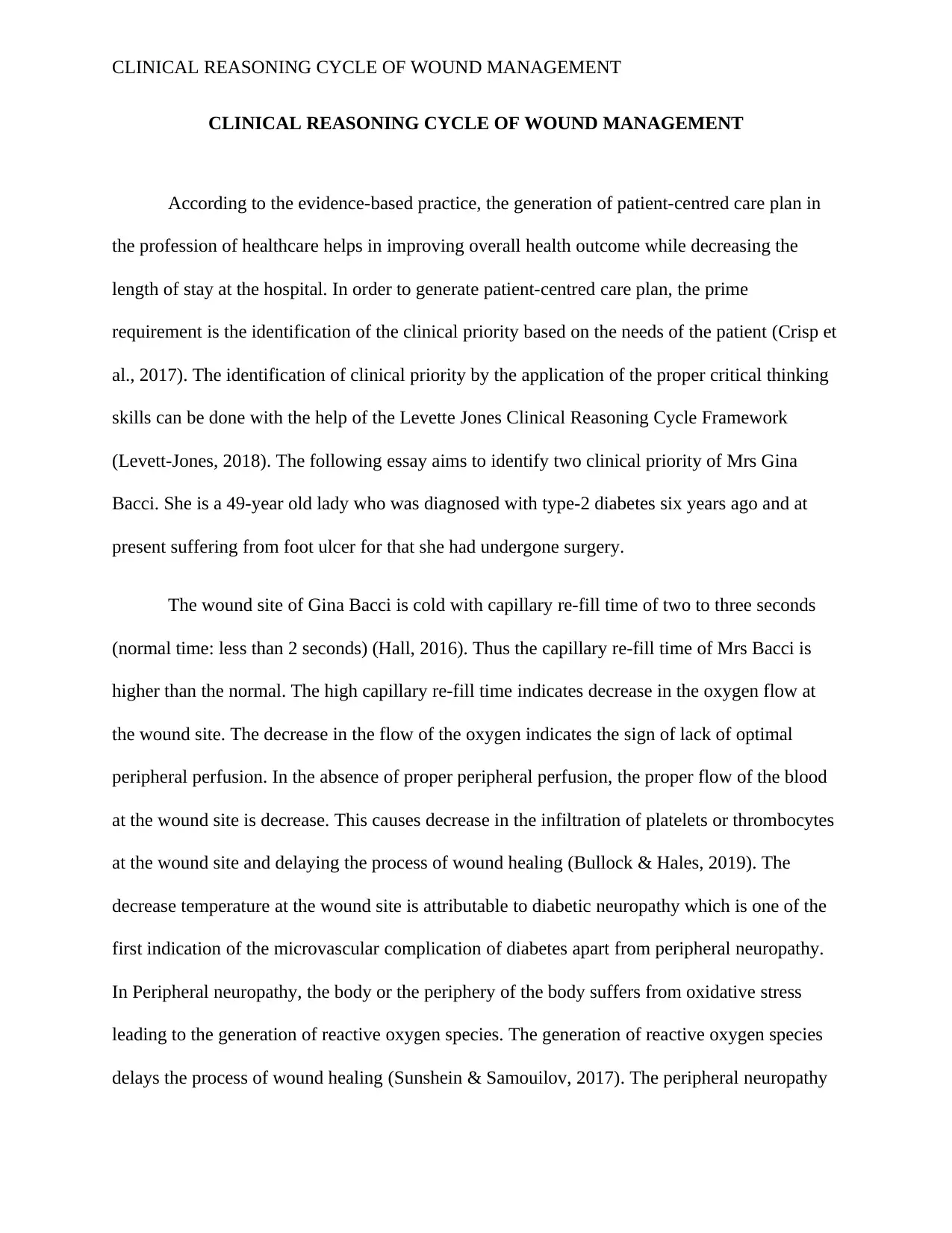
CLINICAL REASONING CYCLE OF WOUND MANAGEMENT
CLINICAL REASONING CYCLE OF WOUND MANAGEMENT
According to the evidence-based practice, the generation of patient-centred care plan in
the profession of healthcare helps in improving overall health outcome while decreasing the
length of stay at the hospital. In order to generate patient-centred care plan, the prime
requirement is the identification of the clinical priority based on the needs of the patient (Crisp et
al., 2017). The identification of clinical priority by the application of the proper critical thinking
skills can be done with the help of the Levette Jones Clinical Reasoning Cycle Framework
(Levett-Jones, 2018). The following essay aims to identify two clinical priority of Mrs Gina
Bacci. She is a 49-year old lady who was diagnosed with type-2 diabetes six years ago and at
present suffering from foot ulcer for that she had undergone surgery.
The wound site of Gina Bacci is cold with capillary re-fill time of two to three seconds
(normal time: less than 2 seconds) (Hall, 2016). Thus the capillary re-fill time of Mrs Bacci is
higher than the normal. The high capillary re-fill time indicates decrease in the oxygen flow at
the wound site. The decrease in the flow of the oxygen indicates the sign of lack of optimal
peripheral perfusion. In the absence of proper peripheral perfusion, the proper flow of the blood
at the wound site is decrease. This causes decrease in the infiltration of platelets or thrombocytes
at the wound site and delaying the process of wound healing (Bullock & Hales, 2019). The
decrease temperature at the wound site is attributable to diabetic neuropathy which is one of the
first indication of the microvascular complication of diabetes apart from peripheral neuropathy.
In Peripheral neuropathy, the body or the periphery of the body suffers from oxidative stress
leading to the generation of reactive oxygen species. The generation of reactive oxygen species
delays the process of wound healing (Sunshein & Samouilov, 2017). The peripheral neuropathy
CLINICAL REASONING CYCLE OF WOUND MANAGEMENT
According to the evidence-based practice, the generation of patient-centred care plan in
the profession of healthcare helps in improving overall health outcome while decreasing the
length of stay at the hospital. In order to generate patient-centred care plan, the prime
requirement is the identification of the clinical priority based on the needs of the patient (Crisp et
al., 2017). The identification of clinical priority by the application of the proper critical thinking
skills can be done with the help of the Levette Jones Clinical Reasoning Cycle Framework
(Levett-Jones, 2018). The following essay aims to identify two clinical priority of Mrs Gina
Bacci. She is a 49-year old lady who was diagnosed with type-2 diabetes six years ago and at
present suffering from foot ulcer for that she had undergone surgery.
The wound site of Gina Bacci is cold with capillary re-fill time of two to three seconds
(normal time: less than 2 seconds) (Hall, 2016). Thus the capillary re-fill time of Mrs Bacci is
higher than the normal. The high capillary re-fill time indicates decrease in the oxygen flow at
the wound site. The decrease in the flow of the oxygen indicates the sign of lack of optimal
peripheral perfusion. In the absence of proper peripheral perfusion, the proper flow of the blood
at the wound site is decrease. This causes decrease in the infiltration of platelets or thrombocytes
at the wound site and delaying the process of wound healing (Bullock & Hales, 2019). The
decrease temperature at the wound site is attributable to diabetic neuropathy which is one of the
first indication of the microvascular complication of diabetes apart from peripheral neuropathy.
In Peripheral neuropathy, the body or the periphery of the body suffers from oxidative stress
leading to the generation of reactive oxygen species. The generation of reactive oxygen species
delays the process of wound healing (Sunshein & Samouilov, 2017). The peripheral neuropathy
Paraphrase This Document
Need a fresh take? Get an instant paraphrase of this document with our AI Paraphraser

1
CLINICAL REASONING CYCLE OF WOUND MANAGEMENT
and diabetic foot ulcer as microvascular complications of diabetes mainly arise due to prolong
tenure of unmanaged state of diabetes. The blood glucose level (BGL) of Mrs Bacci is higher
than the normal (12.6mmol/L; normal: 4.0 to 5.4 mmol/L) with high blood pressure
(12.6mmol/L; normal: 4.0 to 5.4 mmol/L), high level of Basal Metabolic Index [BMI] (40.4m2)
and high body weight (110 Kg with 165 cm height and age 49 years; ideal weight: 56 to 60
kilograms) (Hall, 2016). All the vital statistics and BGL indicates highly unmanaged state of
diabetes and thereby leading to delay in wound healing or diabetic foot ulcer. Han and Ceilley,
(2017) are of the opinion that long-term type 2 diabetes lead to the generation of high blood
glucose level and high level of insulin insensitivity. This might be the case of Mrs Gina Bacci as
she is having high BGL even under insulin medication (Novorapid TDS and Lantus) and thus
further indicating unmanaged diabetes state along with increased chance of diabetic neuropathy
and delay in wound healing (Han & Ceilley, 2017). Huang et al. (2017) reported that unmanaged
state of diabetes also leads to macro vascular complications where the body in unable to convert
LDL (low-density-lipoprotein or bad cholesterol) to HDL (high-density-lipoprotein or good
cholesterol). The LDL gets deposited in the arteries leading to arthrosclerosis. In arthrosclerosis
cause narrowing of arteries, hampering the flow of the blood and thereby reducing the blood
flow at the peripheral parts of the body like feet and hampering the process of wound healing.
The appearance of the serous exudate is the first sign of wound healing but it lasts for two
to three days. However, in case of Mrs Bacci, the presence of serum exudate is still visible after
7 days of the surgery and this can be considered as a process of delayed wound healing (Bryant
& Nix, 2015). The presence of the sloughy tissue at the site of the wound along with dehiscence
along the suture line might have resulted in the use of sock by Mrs Bacci at night in order keep
her feet warm as she used to suffer from cold feet arising out of peripheral diabetic neuropathy.
CLINICAL REASONING CYCLE OF WOUND MANAGEMENT
and diabetic foot ulcer as microvascular complications of diabetes mainly arise due to prolong
tenure of unmanaged state of diabetes. The blood glucose level (BGL) of Mrs Bacci is higher
than the normal (12.6mmol/L; normal: 4.0 to 5.4 mmol/L) with high blood pressure
(12.6mmol/L; normal: 4.0 to 5.4 mmol/L), high level of Basal Metabolic Index [BMI] (40.4m2)
and high body weight (110 Kg with 165 cm height and age 49 years; ideal weight: 56 to 60
kilograms) (Hall, 2016). All the vital statistics and BGL indicates highly unmanaged state of
diabetes and thereby leading to delay in wound healing or diabetic foot ulcer. Han and Ceilley,
(2017) are of the opinion that long-term type 2 diabetes lead to the generation of high blood
glucose level and high level of insulin insensitivity. This might be the case of Mrs Gina Bacci as
she is having high BGL even under insulin medication (Novorapid TDS and Lantus) and thus
further indicating unmanaged diabetes state along with increased chance of diabetic neuropathy
and delay in wound healing (Han & Ceilley, 2017). Huang et al. (2017) reported that unmanaged
state of diabetes also leads to macro vascular complications where the body in unable to convert
LDL (low-density-lipoprotein or bad cholesterol) to HDL (high-density-lipoprotein or good
cholesterol). The LDL gets deposited in the arteries leading to arthrosclerosis. In arthrosclerosis
cause narrowing of arteries, hampering the flow of the blood and thereby reducing the blood
flow at the peripheral parts of the body like feet and hampering the process of wound healing.
The appearance of the serous exudate is the first sign of wound healing but it lasts for two
to three days. However, in case of Mrs Bacci, the presence of serum exudate is still visible after
7 days of the surgery and this can be considered as a process of delayed wound healing (Bryant
& Nix, 2015). The presence of the sloughy tissue at the site of the wound along with dehiscence
along the suture line might have resulted in the use of sock by Mrs Bacci at night in order keep
her feet warm as she used to suffer from cold feet arising out of peripheral diabetic neuropathy.
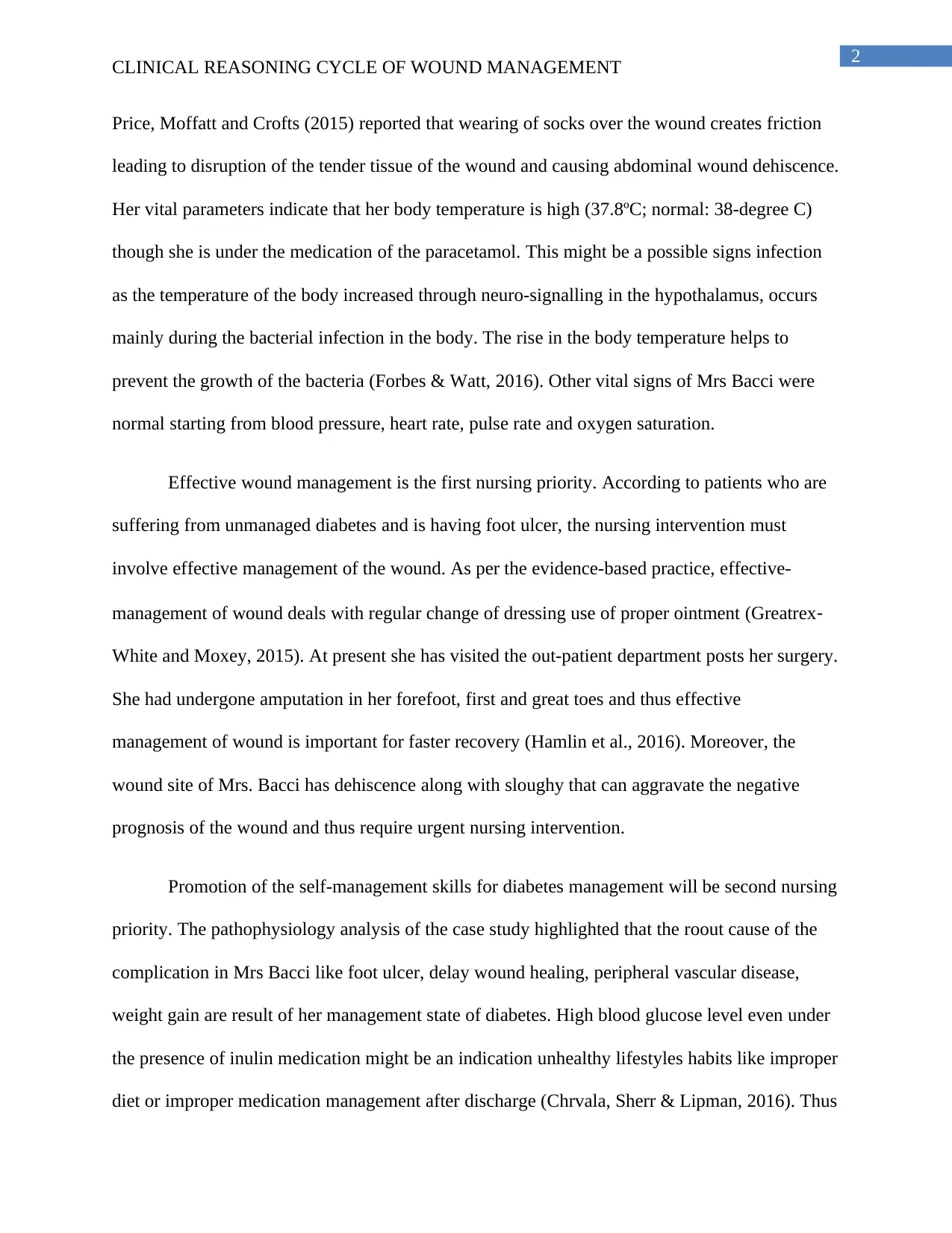
2
CLINICAL REASONING CYCLE OF WOUND MANAGEMENT
Price, Moffatt and Crofts (2015) reported that wearing of socks over the wound creates friction
leading to disruption of the tender tissue of the wound and causing abdominal wound dehiscence.
Her vital parameters indicate that her body temperature is high (37.8ºC; normal: 38-degree C)
though she is under the medication of the paracetamol. This might be a possible signs infection
as the temperature of the body increased through neuro-signalling in the hypothalamus, occurs
mainly during the bacterial infection in the body. The rise in the body temperature helps to
prevent the growth of the bacteria (Forbes & Watt, 2016). Other vital signs of Mrs Bacci were
normal starting from blood pressure, heart rate, pulse rate and oxygen saturation.
Effective wound management is the first nursing priority. According to patients who are
suffering from unmanaged diabetes and is having foot ulcer, the nursing intervention must
involve effective management of the wound. As per the evidence-based practice, effective-
management of wound deals with regular change of dressing use of proper ointment (Greatrex‐
White and Moxey, 2015). At present she has visited the out-patient department posts her surgery.
She had undergone amputation in her forefoot, first and great toes and thus effective
management of wound is important for faster recovery (Hamlin et al., 2016). Moreover, the
wound site of Mrs. Bacci has dehiscence along with sloughy that can aggravate the negative
prognosis of the wound and thus require urgent nursing intervention.
Promotion of the self-management skills for diabetes management will be second nursing
priority. The pathophysiology analysis of the case study highlighted that the roout cause of the
complication in Mrs Bacci like foot ulcer, delay wound healing, peripheral vascular disease,
weight gain are result of her management state of diabetes. High blood glucose level even under
the presence of inulin medication might be an indication unhealthy lifestyles habits like improper
diet or improper medication management after discharge (Chrvala, Sherr & Lipman, 2016). Thus
CLINICAL REASONING CYCLE OF WOUND MANAGEMENT
Price, Moffatt and Crofts (2015) reported that wearing of socks over the wound creates friction
leading to disruption of the tender tissue of the wound and causing abdominal wound dehiscence.
Her vital parameters indicate that her body temperature is high (37.8ºC; normal: 38-degree C)
though she is under the medication of the paracetamol. This might be a possible signs infection
as the temperature of the body increased through neuro-signalling in the hypothalamus, occurs
mainly during the bacterial infection in the body. The rise in the body temperature helps to
prevent the growth of the bacteria (Forbes & Watt, 2016). Other vital signs of Mrs Bacci were
normal starting from blood pressure, heart rate, pulse rate and oxygen saturation.
Effective wound management is the first nursing priority. According to patients who are
suffering from unmanaged diabetes and is having foot ulcer, the nursing intervention must
involve effective management of the wound. As per the evidence-based practice, effective-
management of wound deals with regular change of dressing use of proper ointment (Greatrex‐
White and Moxey, 2015). At present she has visited the out-patient department posts her surgery.
She had undergone amputation in her forefoot, first and great toes and thus effective
management of wound is important for faster recovery (Hamlin et al., 2016). Moreover, the
wound site of Mrs. Bacci has dehiscence along with sloughy that can aggravate the negative
prognosis of the wound and thus require urgent nursing intervention.
Promotion of the self-management skills for diabetes management will be second nursing
priority. The pathophysiology analysis of the case study highlighted that the roout cause of the
complication in Mrs Bacci like foot ulcer, delay wound healing, peripheral vascular disease,
weight gain are result of her management state of diabetes. High blood glucose level even under
the presence of inulin medication might be an indication unhealthy lifestyles habits like improper
diet or improper medication management after discharge (Chrvala, Sherr & Lipman, 2016). Thus
⊘ This is a preview!⊘
Do you want full access?
Subscribe today to unlock all pages.

Trusted by 1+ million students worldwide

3
CLINICAL REASONING CYCLE OF WOUND MANAGEMENT
promotion of the self-management skills of diabetes will help to increase the disease awareness
and thereby promoting adherence to healthy lifestyle habits and at the same time will to promote
therapy adherence. Proper implementation of the pharmacological and non-pharmacological
interventions helps to reduce the BGL and thereby helping to manage diabetes. Proper
management of diabetes will help to improve overall health and well-being of Mrs Bacci
(Powers et al., 2017).
In order to promote self-management of diabetes, patient education will be the nursing
intervention. As per the Australian Commission on Safety and Quality in Health Care
(ACSQHC) (2012), Standard 2 of the National Safety and Quality Health Service Standards
promotes partnering with the consumers helps in improving the overall outcome of the care by
promoting therapy adherence. This partnering of the consumers can be done through effective
interaction with the consumers and by educating the consumers about the disease progression.
Education of the diabetes management must be directed towards the therapy plan and how the
proper use of the healthy lifestyle habits helps to reduce the diabetic outcome (Chrvala, Sherr &
Lipman, 2016). The patient education also helps to promote clinical governance (standard 1) of
ACSQHSC (2012).Promotion of clinical governance will help to reduce medication error and
will make the patient to feel more empowerment in the domain of effective disease management.
The first education of the disease management for Mrs Bacci will be directed towards the
importance of the medication, external supply of insulin through subcutaneous injection is
helpful in reducing the elevated level of BGL. Mrs Bacci at times feels that she needs not to take
medication. Education among the disease progression will help her understand the importance of
medication and thus increasing medication adherence. Since she frequently forgets, to take
medicine and hence her primary care givers will also be educated about the importance of the
CLINICAL REASONING CYCLE OF WOUND MANAGEMENT
promotion of the self-management skills of diabetes will help to increase the disease awareness
and thereby promoting adherence to healthy lifestyle habits and at the same time will to promote
therapy adherence. Proper implementation of the pharmacological and non-pharmacological
interventions helps to reduce the BGL and thereby helping to manage diabetes. Proper
management of diabetes will help to improve overall health and well-being of Mrs Bacci
(Powers et al., 2017).
In order to promote self-management of diabetes, patient education will be the nursing
intervention. As per the Australian Commission on Safety and Quality in Health Care
(ACSQHC) (2012), Standard 2 of the National Safety and Quality Health Service Standards
promotes partnering with the consumers helps in improving the overall outcome of the care by
promoting therapy adherence. This partnering of the consumers can be done through effective
interaction with the consumers and by educating the consumers about the disease progression.
Education of the diabetes management must be directed towards the therapy plan and how the
proper use of the healthy lifestyle habits helps to reduce the diabetic outcome (Chrvala, Sherr &
Lipman, 2016). The patient education also helps to promote clinical governance (standard 1) of
ACSQHSC (2012).Promotion of clinical governance will help to reduce medication error and
will make the patient to feel more empowerment in the domain of effective disease management.
The first education of the disease management for Mrs Bacci will be directed towards the
importance of the medication, external supply of insulin through subcutaneous injection is
helpful in reducing the elevated level of BGL. Mrs Bacci at times feels that she needs not to take
medication. Education among the disease progression will help her understand the importance of
medication and thus increasing medication adherence. Since she frequently forgets, to take
medicine and hence her primary care givers will also be educated about the importance of the
Paraphrase This Document
Need a fresh take? Get an instant paraphrase of this document with our AI Paraphraser

4
CLINICAL REASONING CYCLE OF WOUND MANAGEMENT
medication management in diabetes (Powers et al., 2017). The second education will be directed
towards importance of healthy lifestyle in the management of the disease. Here diet plan will be
given primary preference because at present Mrs Bacci is not fit for conducting physical activity
due to her wound in the foot. The diet plan that will be suitable Mrs Bacci will be high protein
low calorie diet. Low calorie diet will help to reduce the blood glucose level and the same time
will help to reduce the body weight and thus helping to manage diabetes (Feinman et al., 2015).
Education will also be given in prohibition of wearing of socks at night. Education to Mrs Bacci
about disease progression and development of the self-management skills of diabetes will be
given in the presence of a culturally and linguistically diverse (CALD) nurse who is well-
accustomed in Italian language. Mrs. Bacci is an Italian and thus proper translation of English in
Italian language will be important to make Mrs. Bacci understand the process of disease
management clearly. The presence of CALD nurse will help increase the participation of the
patient in the care plan (Zeh et al., 2018). The evaluation of the outcome will be done based
reduction in BGL.
Second nursing intervention will be dressing of wound along with administration of
proper medication for effective management of disease. The wound site of Mrs Bacci is wet due
to serous exudate. In order to keep the wound area dry, removal and replacement of the Island
dressing is important. Island dressing with its absorbent pad will help to soak the extra moisture
and exudate from the wound and helping to heal further. The wound site is pink-read, warm and
painful. This might indicate the sign of impending bacterial infection and can be treated by
proper administration of antibiotics. Use of broad spectrum antibiotic will help to reduce pain
and effective management of the microbial infection (Bryant & Nix, 2015). Administration of
CLINICAL REASONING CYCLE OF WOUND MANAGEMENT
medication management in diabetes (Powers et al., 2017). The second education will be directed
towards importance of healthy lifestyle in the management of the disease. Here diet plan will be
given primary preference because at present Mrs Bacci is not fit for conducting physical activity
due to her wound in the foot. The diet plan that will be suitable Mrs Bacci will be high protein
low calorie diet. Low calorie diet will help to reduce the blood glucose level and the same time
will help to reduce the body weight and thus helping to manage diabetes (Feinman et al., 2015).
Education will also be given in prohibition of wearing of socks at night. Education to Mrs Bacci
about disease progression and development of the self-management skills of diabetes will be
given in the presence of a culturally and linguistically diverse (CALD) nurse who is well-
accustomed in Italian language. Mrs. Bacci is an Italian and thus proper translation of English in
Italian language will be important to make Mrs. Bacci understand the process of disease
management clearly. The presence of CALD nurse will help increase the participation of the
patient in the care plan (Zeh et al., 2018). The evaluation of the outcome will be done based
reduction in BGL.
Second nursing intervention will be dressing of wound along with administration of
proper medication for effective management of disease. The wound site of Mrs Bacci is wet due
to serous exudate. In order to keep the wound area dry, removal and replacement of the Island
dressing is important. Island dressing with its absorbent pad will help to soak the extra moisture
and exudate from the wound and helping to heal further. The wound site is pink-read, warm and
painful. This might indicate the sign of impending bacterial infection and can be treated by
proper administration of antibiotics. Use of broad spectrum antibiotic will help to reduce pain
and effective management of the microbial infection (Bryant & Nix, 2015). Administration of
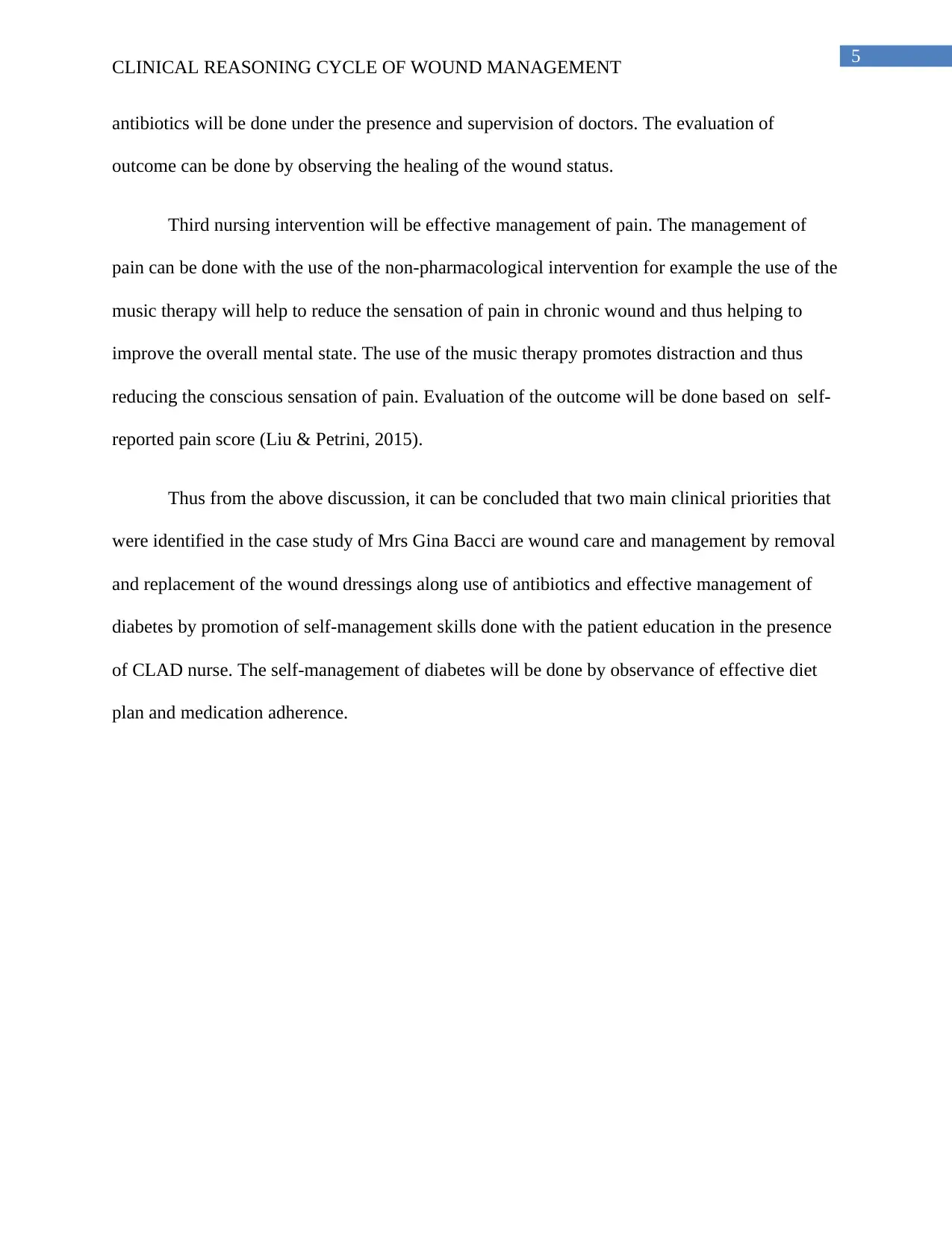
5
CLINICAL REASONING CYCLE OF WOUND MANAGEMENT
antibiotics will be done under the presence and supervision of doctors. The evaluation of
outcome can be done by observing the healing of the wound status.
Third nursing intervention will be effective management of pain. The management of
pain can be done with the use of the non-pharmacological intervention for example the use of the
music therapy will help to reduce the sensation of pain in chronic wound and thus helping to
improve the overall mental state. The use of the music therapy promotes distraction and thus
reducing the conscious sensation of pain. Evaluation of the outcome will be done based on self-
reported pain score (Liu & Petrini, 2015).
Thus from the above discussion, it can be concluded that two main clinical priorities that
were identified in the case study of Mrs Gina Bacci are wound care and management by removal
and replacement of the wound dressings along use of antibiotics and effective management of
diabetes by promotion of self-management skills done with the patient education in the presence
of CLAD nurse. The self-management of diabetes will be done by observance of effective diet
plan and medication adherence.
CLINICAL REASONING CYCLE OF WOUND MANAGEMENT
antibiotics will be done under the presence and supervision of doctors. The evaluation of
outcome can be done by observing the healing of the wound status.
Third nursing intervention will be effective management of pain. The management of
pain can be done with the use of the non-pharmacological intervention for example the use of the
music therapy will help to reduce the sensation of pain in chronic wound and thus helping to
improve the overall mental state. The use of the music therapy promotes distraction and thus
reducing the conscious sensation of pain. Evaluation of the outcome will be done based on self-
reported pain score (Liu & Petrini, 2015).
Thus from the above discussion, it can be concluded that two main clinical priorities that
were identified in the case study of Mrs Gina Bacci are wound care and management by removal
and replacement of the wound dressings along use of antibiotics and effective management of
diabetes by promotion of self-management skills done with the patient education in the presence
of CLAD nurse. The self-management of diabetes will be done by observance of effective diet
plan and medication adherence.
⊘ This is a preview!⊘
Do you want full access?
Subscribe today to unlock all pages.

Trusted by 1+ million students worldwide
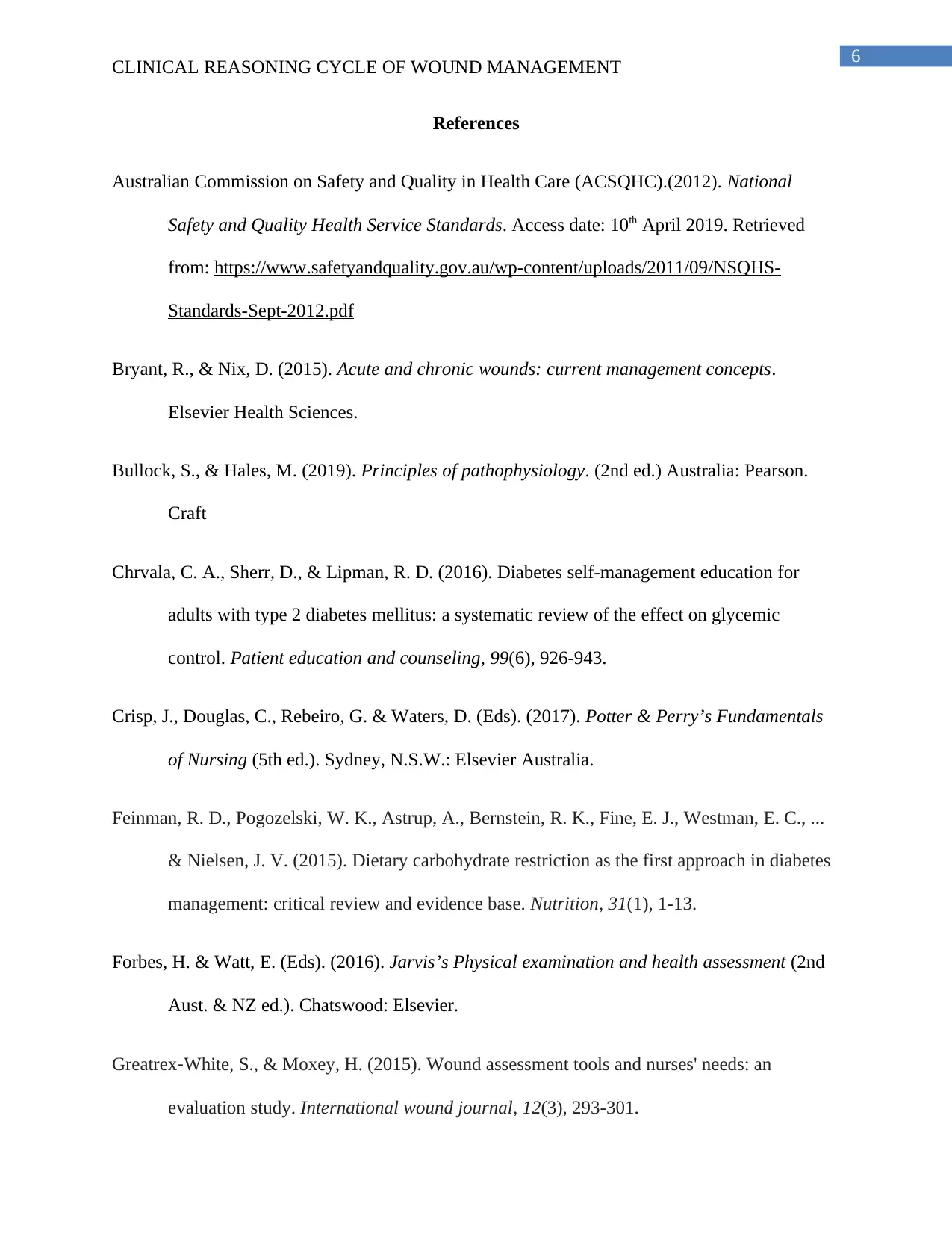
6
CLINICAL REASONING CYCLE OF WOUND MANAGEMENT
References
Australian Commission on Safety and Quality in Health Care (ACSQHC).(2012). National
Safety and Quality Health Service Standards. Access date: 10th April 2019. Retrieved
from: https://www.safetyandquality.gov.au/wp-content/uploads/2011/09/NSQHS-
Standards-Sept-2012.pdf
Bryant, R., & Nix, D. (2015). Acute and chronic wounds: current management concepts.
Elsevier Health Sciences.
Bullock, S., & Hales, M. (2019). Principles of pathophysiology. (2nd ed.) Australia: Pearson.
Craft
Chrvala, C. A., Sherr, D., & Lipman, R. D. (2016). Diabetes self-management education for
adults with type 2 diabetes mellitus: a systematic review of the effect on glycemic
control. Patient education and counseling, 99(6), 926-943.
Crisp, J., Douglas, C., Rebeiro, G. & Waters, D. (Eds). (2017). Potter & Perry’s Fundamentals
of Nursing (5th ed.). Sydney, N.S.W.: Elsevier Australia.
Feinman, R. D., Pogozelski, W. K., Astrup, A., Bernstein, R. K., Fine, E. J., Westman, E. C., ...
& Nielsen, J. V. (2015). Dietary carbohydrate restriction as the first approach in diabetes
management: critical review and evidence base. Nutrition, 31(1), 1-13.
Forbes, H. & Watt, E. (Eds). (2016). Jarvis’s Physical examination and health assessment (2nd
Aust. & NZ ed.). Chatswood: Elsevier.
Greatrex‐White, S., & Moxey, H. (2015). Wound assessment tools and nurses' needs: an
evaluation study. International wound journal, 12(3), 293-301.
CLINICAL REASONING CYCLE OF WOUND MANAGEMENT
References
Australian Commission on Safety and Quality in Health Care (ACSQHC).(2012). National
Safety and Quality Health Service Standards. Access date: 10th April 2019. Retrieved
from: https://www.safetyandquality.gov.au/wp-content/uploads/2011/09/NSQHS-
Standards-Sept-2012.pdf
Bryant, R., & Nix, D. (2015). Acute and chronic wounds: current management concepts.
Elsevier Health Sciences.
Bullock, S., & Hales, M. (2019). Principles of pathophysiology. (2nd ed.) Australia: Pearson.
Craft
Chrvala, C. A., Sherr, D., & Lipman, R. D. (2016). Diabetes self-management education for
adults with type 2 diabetes mellitus: a systematic review of the effect on glycemic
control. Patient education and counseling, 99(6), 926-943.
Crisp, J., Douglas, C., Rebeiro, G. & Waters, D. (Eds). (2017). Potter & Perry’s Fundamentals
of Nursing (5th ed.). Sydney, N.S.W.: Elsevier Australia.
Feinman, R. D., Pogozelski, W. K., Astrup, A., Bernstein, R. K., Fine, E. J., Westman, E. C., ...
& Nielsen, J. V. (2015). Dietary carbohydrate restriction as the first approach in diabetes
management: critical review and evidence base. Nutrition, 31(1), 1-13.
Forbes, H. & Watt, E. (Eds). (2016). Jarvis’s Physical examination and health assessment (2nd
Aust. & NZ ed.). Chatswood: Elsevier.
Greatrex‐White, S., & Moxey, H. (2015). Wound assessment tools and nurses' needs: an
evaluation study. International wound journal, 12(3), 293-301.
Paraphrase This Document
Need a fresh take? Get an instant paraphrase of this document with our AI Paraphraser

7
CLINICAL REASONING CYCLE OF WOUND MANAGEMENT
Hall, J. E. (2015). Guyton & Hall Physiology Review E-Book. Elsevier Health Sciences.
Hamlin, L., Davies, M., Richardson-Tench, M. & Sutherland-Fraser, S. (Eds.). (2016).
Perioperative nursing: An introduction. (2nd ed.) Chatswood: Elsevier Australia.
Han, G., & Ceilley, R. (2017). Chronic wound healing: a review of current management and
treatments. Advances in therapy, 34(3), 599-610.
Huang, D., Refaat, M., Mohammedi, K., Jayyousi, A., Al Suwaidi, J., & Abi Khalil, C. (2017).
Macrovascular complications in patients with diabetes and prediabetes. BioMed research
international, 2017.
Levett-Jones, T. (Ed.) (2018) Clinical Reasoning: Learning to think like a nurse. (2nd ed.)
Frenchs Forest, N.S.W.: Pearson.
Liu, Y., & Petrini, M. A. (2015). Effects of music therapy on pain, anxiety, and vital signs in
patients after thoracic surgery. Complementary therapies in medicine, 23(5), 714-718.
Powers, M. A., Bardsley, J., Cypress, M., Duker, P., Funnell, M. M., Fischl, A. H., ... & Vivian,
E. (2017). Diabetes self-management education and support in type 2 diabetes: a joint
position statement of the American Diabetes Association, the American Association of
Diabetes Educators, and the Academy of Nutrition and Dietetics. The Diabetes
Educator, 43(1), 40-53.
Price, B., Moffatt, B., & Crofts, D. (2015). Managing patients following a lower limb
amputation. Journal of Community Nursing, 29(3), 26-33.
Sunshein, K. F., & Samouilov, A. (2017). Evaluation of peripheral neuropathy in the diabetic
foot. Primary Care Reports, 23(3).
CLINICAL REASONING CYCLE OF WOUND MANAGEMENT
Hall, J. E. (2015). Guyton & Hall Physiology Review E-Book. Elsevier Health Sciences.
Hamlin, L., Davies, M., Richardson-Tench, M. & Sutherland-Fraser, S. (Eds.). (2016).
Perioperative nursing: An introduction. (2nd ed.) Chatswood: Elsevier Australia.
Han, G., & Ceilley, R. (2017). Chronic wound healing: a review of current management and
treatments. Advances in therapy, 34(3), 599-610.
Huang, D., Refaat, M., Mohammedi, K., Jayyousi, A., Al Suwaidi, J., & Abi Khalil, C. (2017).
Macrovascular complications in patients with diabetes and prediabetes. BioMed research
international, 2017.
Levett-Jones, T. (Ed.) (2018) Clinical Reasoning: Learning to think like a nurse. (2nd ed.)
Frenchs Forest, N.S.W.: Pearson.
Liu, Y., & Petrini, M. A. (2015). Effects of music therapy on pain, anxiety, and vital signs in
patients after thoracic surgery. Complementary therapies in medicine, 23(5), 714-718.
Powers, M. A., Bardsley, J., Cypress, M., Duker, P., Funnell, M. M., Fischl, A. H., ... & Vivian,
E. (2017). Diabetes self-management education and support in type 2 diabetes: a joint
position statement of the American Diabetes Association, the American Association of
Diabetes Educators, and the Academy of Nutrition and Dietetics. The Diabetes
Educator, 43(1), 40-53.
Price, B., Moffatt, B., & Crofts, D. (2015). Managing patients following a lower limb
amputation. Journal of Community Nursing, 29(3), 26-33.
Sunshein, K. F., & Samouilov, A. (2017). Evaluation of peripheral neuropathy in the diabetic
foot. Primary Care Reports, 23(3).
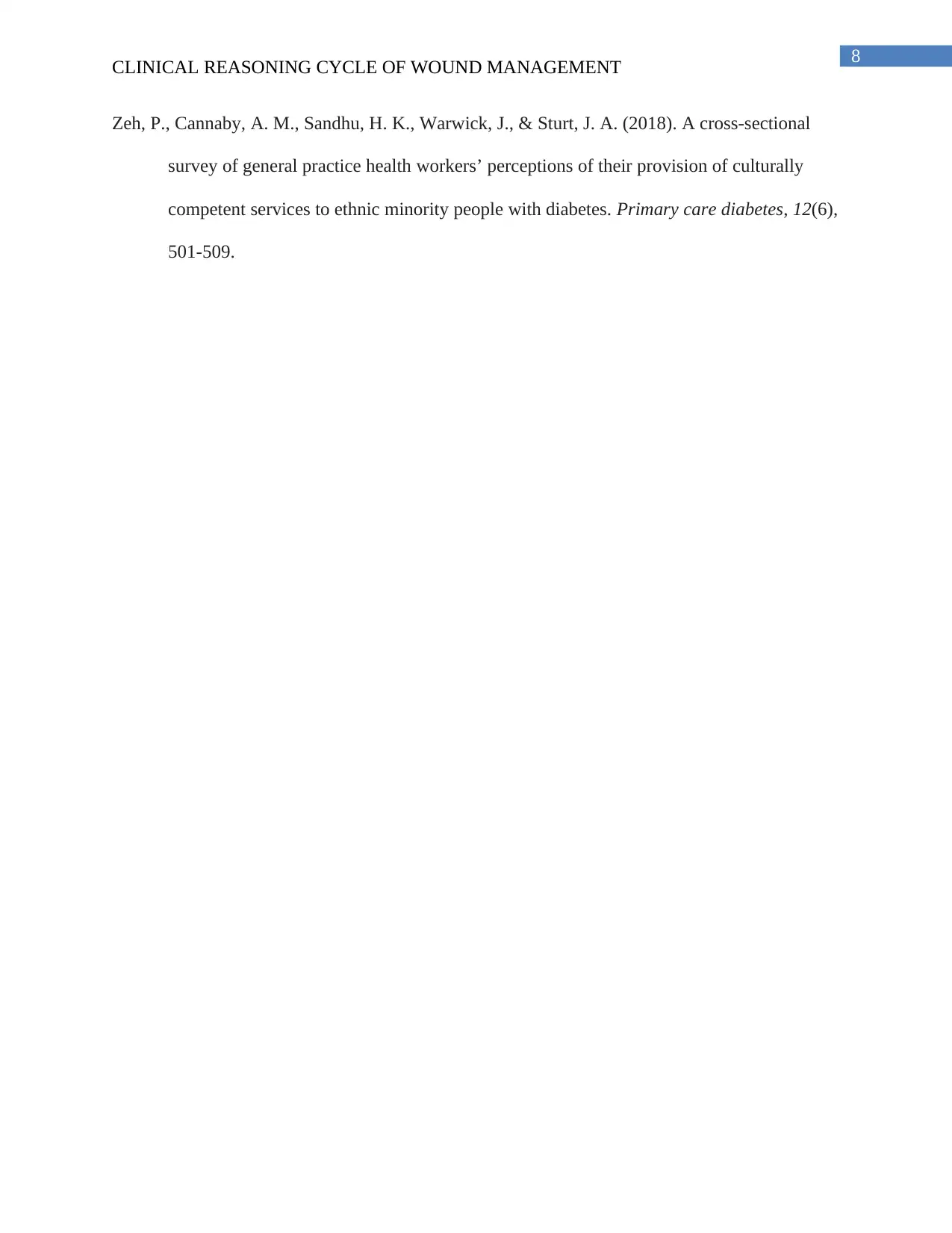
8
CLINICAL REASONING CYCLE OF WOUND MANAGEMENT
Zeh, P., Cannaby, A. M., Sandhu, H. K., Warwick, J., & Sturt, J. A. (2018). A cross-sectional
survey of general practice health workers’ perceptions of their provision of culturally
competent services to ethnic minority people with diabetes. Primary care diabetes, 12(6),
501-509.
CLINICAL REASONING CYCLE OF WOUND MANAGEMENT
Zeh, P., Cannaby, A. M., Sandhu, H. K., Warwick, J., & Sturt, J. A. (2018). A cross-sectional
survey of general practice health workers’ perceptions of their provision of culturally
competent services to ethnic minority people with diabetes. Primary care diabetes, 12(6),
501-509.
⊘ This is a preview!⊘
Do you want full access?
Subscribe today to unlock all pages.

Trusted by 1+ million students worldwide
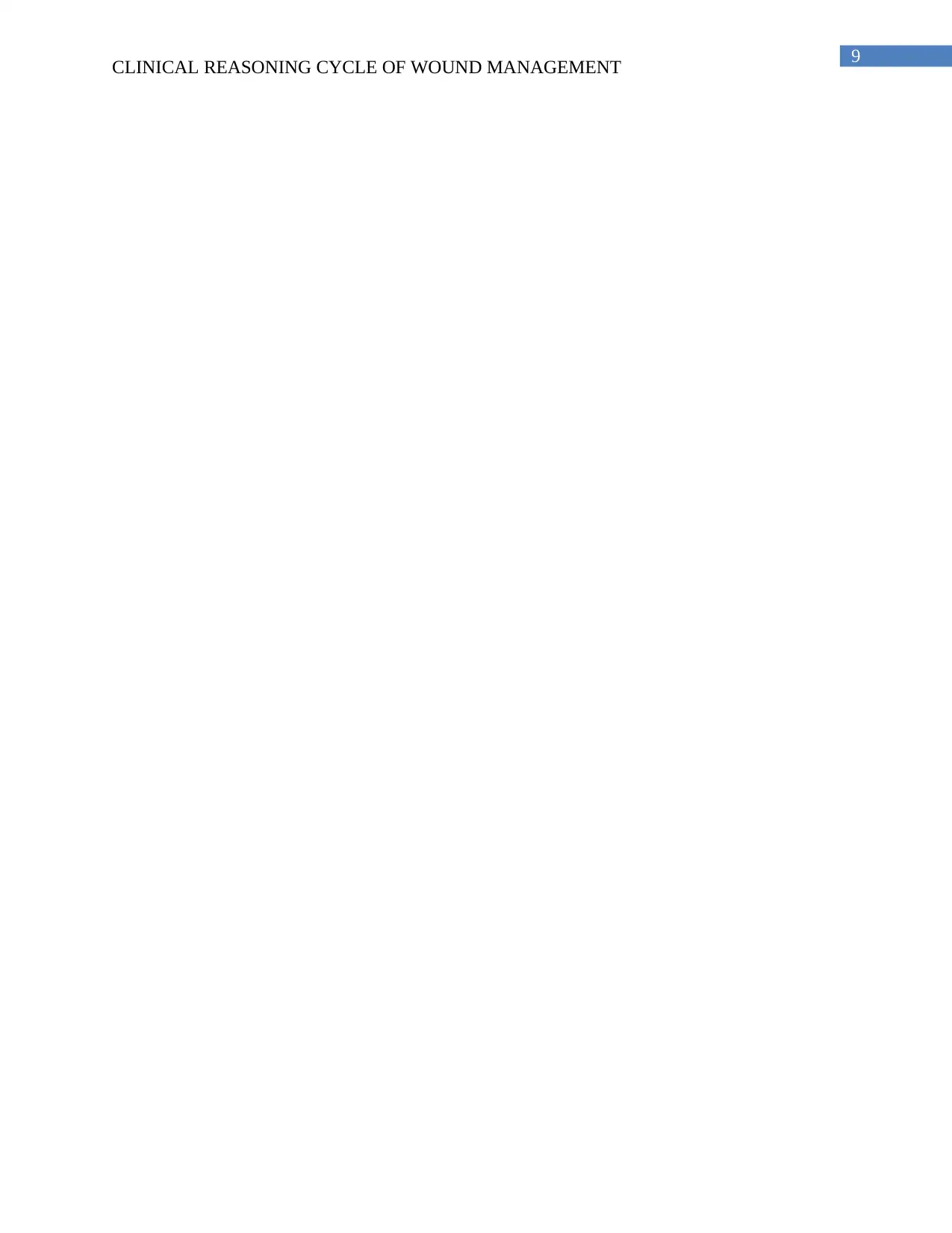
9
CLINICAL REASONING CYCLE OF WOUND MANAGEMENT
CLINICAL REASONING CYCLE OF WOUND MANAGEMENT
1 out of 10
Related Documents
Your All-in-One AI-Powered Toolkit for Academic Success.
+13062052269
info@desklib.com
Available 24*7 on WhatsApp / Email
![[object Object]](/_next/static/media/star-bottom.7253800d.svg)
Unlock your academic potential
Copyright © 2020–2025 A2Z Services. All Rights Reserved. Developed and managed by ZUCOL.





